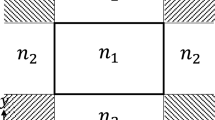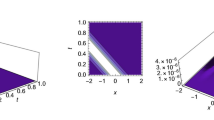Abstract
A one-dimensional anisotropic photonic crystal is considered. A mathematical model is constructed that separates an elliptical polarization wave into TE- and TM-type waves. The transformation matrix is found for a periodic structure with an arbitrary number of layers in a period in the form of a block diagonal matrix. The transformation matrix is found for an arbitrary number of periods of the structure with anisotropic layers. Dispersion relations are found that determine the boundaries of the allowed zones.



Similar content being viewed by others
REFERENCES
E. Yablonovitch, Phys. Rev. Lett., No. 58, 2059 (1987).
Z. V. Vardeny, A. Nahata, and A. Agrawal, Nat. Photonics 7, 177 (2013).
D. W. Berreman, J. Opt. Soc. Am. 62, 502 (1972).
S. Mingaleev and Y. Kivshar, Optics Photonics News 13 (7), 48 (2002).
O. Jedrkiewicz, A. Gatti, E. Brambilla, et al., Eur. Conf. on Lasers and Electro-Optics (CLEO Europe), Munich, Jun. 25–29, 2017 (IEEE, New Yune, 2017).
T. Zhan, X. Shi, Yu. Dai, et al., J. Phys. Condens. Matter 25, 215301 (2013).
K. A. Vytovtov and Yu. S. Tarasenko, J. Opt. Soc. Am. A 24, 3564 (2007).
K. Vytovtov, J. Opt. Soc. Am. A 22, 689 (2005).
K. A. Vytovtov, J. Commun. Technol. Electron. 462, 144 (2001).
N. C. Passler and A. Paarmann, J. Opt. Soc. Am. 34, 2128 (2017).
F. R. Gantmacher, The Theory of Matrices (Nauka, Moscow, 1962; Chelsea, New York, 1959).
F. Abeles, Ann. Physique 5, 596 (1950).
M. Born and E. Wolf, Principles of Optics: Electromagnetic Theory of Propagation, Interference, and Diffraction of Light (Pergamon, Oxford, 1964; Nauka, Moscow, 1973).
Author information
Authors and Affiliations
Corresponding author
Additional information
The study was presented at the Third International Youth Conference “Information and Communication Technologies: Modern Achievements” (Astrakhan, October 1–5, 2019).
APPENDIX
APPENDIX
The transformation matrix of a TE-wave [7] has the form
where
and the factors of influence \({{\xi }_{{1,2}}}\) and \({{\zeta }_{{1,2}}}\) are defined by the expressions
The transformation matrix of a TM-wave [7] has the form
Thus, in [7], the transformation matrix is represented as a diagonal block matrix.
Rights and permissions
About this article
Cite this article
Vytovtov, K.A., Barabanova, E.A., Vishnevsky, V.M. et al. Mathematical Model for the Separation of an Elliptically Polarized Wave in Anisotropic Photonic Crystals into TE- and TM-Waves. J. Commun. Technol. Electron. 65, 763–770 (2020). https://doi.org/10.1134/S1064226920070153
Received:
Revised:
Accepted:
Published:
Issue Date:
DOI: https://doi.org/10.1134/S1064226920070153




